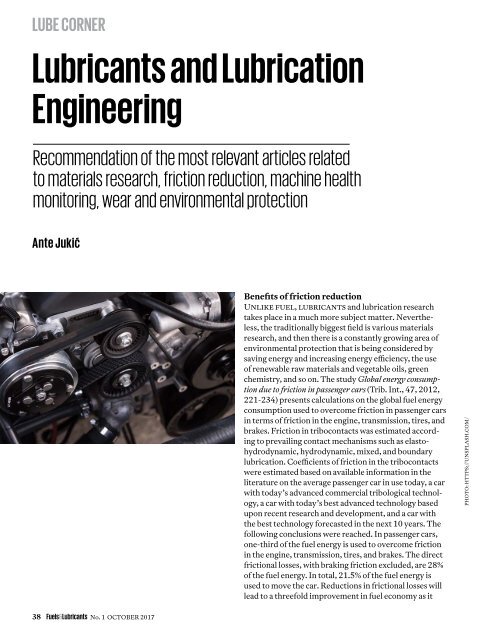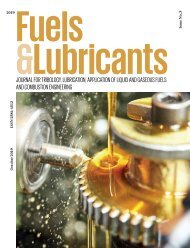Fuels & Lubricants Magazine
Issue 1, October 2017
Issue 1, October 2017
Create successful ePaper yourself
Turn your PDF publications into a flip-book with our unique Google optimized e-Paper software.
Lube Corner<br />
<strong>Lubricants</strong> and Lubrication<br />
Engineering<br />
Recommendation of the most relevant articles related<br />
to materials research, friction reduction, machine health<br />
monitoring, wear and environmental protection<br />
Ante Jukić<br />
Benefits of friction reduction<br />
Unlike fuel, lubricants and lubrication research<br />
takes place in a much more subject matter. Nevertheless,<br />
the traditionally biggest field is various materials<br />
research, and then there is a constantly growing area of <br />
environmental protection that is being considered by<br />
saving energy and increasing energy efficiency, the use<br />
of renewable raw materials and vegetable oils, green<br />
chemistry, and so on. The study Global energy consumption<br />
due to friction in passenger cars (Trib. Int., 47, 2012,<br />
221-234) presents calculations on the global fuel energy<br />
consumption used to overcome friction in passenger cars<br />
in terms of friction in the engine, transmission, tires, and<br />
brakes. Friction in tribocontacts was estimated according<br />
to prevailing contact mechanisms such as elastohydrodynamic,<br />
hydrodynamic, mixed, and boundary<br />
lubrication. Coefficients of friction in the tribocontacts<br />
were estimated based on available information in the<br />
literature on the average passenger car in use today, a car<br />
with today’s advanced commercial tribological technology,<br />
a car with today’s best advanced technology based<br />
upon recent research and development, and a car with<br />
the best technology forecasted in the next 10 years. The<br />
following conclusions were reached. In passenger cars,<br />
one-third of the fuel energy is used to overcome friction<br />
in the engine, transmission, tires, and brakes. The direct<br />
frictional losses, with braking friction excluded, are 28%<br />
of the fuel energy. In total, 21.5% of the fuel energy is<br />
used to move the car. Reductions in frictional losses will<br />
lead to a threefold improvement in fuel economy as it<br />
photo: https://unsplash.com/<br />
38 <strong>Fuels</strong>&<strong>Lubricants</strong> No. 1 OCTOBER 2017







